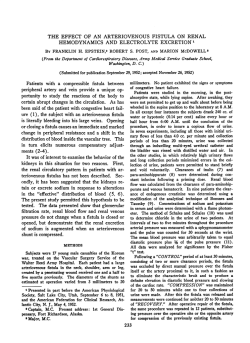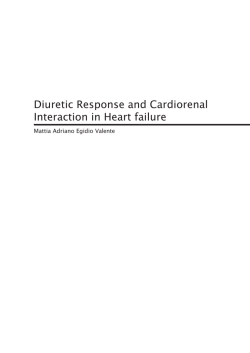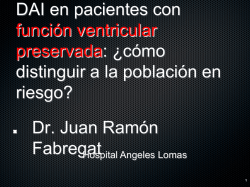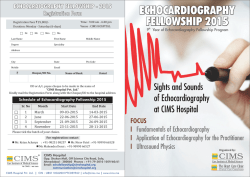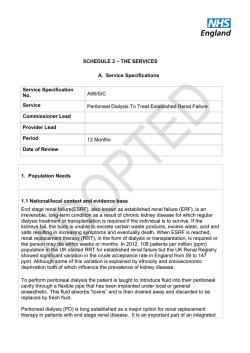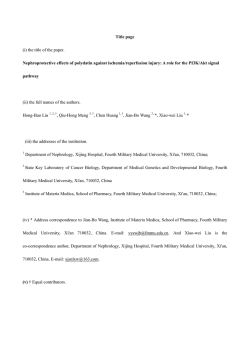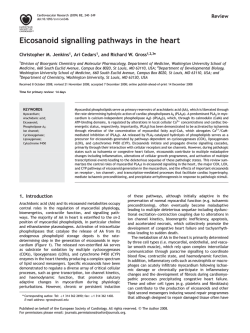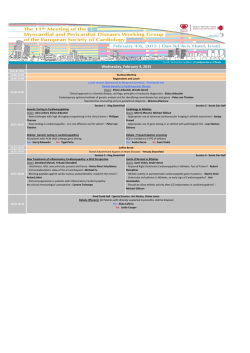
The impact of arteriovenous fistula formation on central
The Impact of Arteriovenous Fistula Formation on Central Hemodynamic Pressures in Chronic Renal Failure Patients: A Prospective Study M. Tessa Savage, PhD, Charles J. Ferro, MD, Antonio Sassano, MSc, and Charles R.V. Tomson, DM ● Background: The presence of an arteriovenous (AV) fistula creates permanently high cardiac output. This may cause an imbalance between available cardiac oxygen supply in response to greater demand and increased arterial stiffness. Methods: Surrogate markers of subendocardial perfusion (subendocardial viability ratio [SEVR]) and arterial stiffness (augmentation index [AIx]) can be measured noninvasively by using pulse wave analysis on the radial pulse to obtain central pressures. We prospectively followed up nine patients with chronic renal failure (CRF) undergoing creation of an AV fistula for vascular access at regular intervals over 6 months. Results: After surgery, blood pressure and heart rate remained unchanged throughout the study period. AIx stayed the same (baseline versus 6 months, 20% ؎ 11% versus 22% ؎ 15%), but there was a decrease in SEVR immediately after surgery (؊9% ؎ 5%; P < 0.05) that persisted for at least 3 months (؊14% ؎ 7%; P < 0.01). At 6 months, SEVR remained below baseline values in all but one patient (mean SEVR at baseline, 166% ؎ 22% versus 6 months, 150% ؎ 20%; P < 0.05; ؊9% ؎ 7%). Conclusion: Creation of an AV fistula may directly predispose patients with CRF to a risk for myocardial ischemia caused by an adverse imbalance between subendocardial oxygen supply and increased oxygen demand consequent to a greater cardiac output. © 2002 by the National Kidney Foundation, Inc. INDEX WORDS: Chronic renal failure (CRF); arteriovenous (AV) fistula; pulse wave analysis; augmentation index (AIx); subendocardial viability ratio (SEVR). C REATION OF AN arteriovenous (AV) fistula in patients with chronic renal failure (CRF) for use as vascular access for hemodialysis has been successfully practiced since its advent in the early 1960s.1 Formation of an AV fistula imposes immediate cardiovascular effects: total peripheral resistance is reduced and cardiac output is increased because of the greatly enhanced venous return to the heart and subsequent increase in both myocardial contractility (Frank-Starling mechanism) and heart rate.2-4 The resultant greater cardiac output creates a hyperdynamic circulation that contributes to the vascular remodeling in uremia5 and probably also to arterial stiffness, itself a potent predictor of cardiovascular disease and death in patients with CRF.6 The presence of an AV fistula is often cited as a cardiovascular risk factor5 and has been reported as a direct cause of congestive heart failure in isolated cases,7-10 although this is a rare complication.2,10 However, in a prospective study, creation of an AV fistula was shown to cause an increase in heart size and cardiac output determined by echocardiography just 2 weeks postoperatively.11 Moreover, compression of an AV fistula for only 1 minute was shown to alter cardiac oxygen supply.12 The use of pulse wave analysis permits assessment of the central pressure waveform and de- rived parameters from a peripheral pressure waveform. These parameters include the augmentation index (AIx; a surrogate marker of systemic arterial stiffness)13 and subendocardial viability ratio (SEVR), a sensitive surrogate marker of subendocardial oxygen supply and demand that correlates with myocardial ischemia.14 We hypothesized that the greater cardiac output imposed on patients with CRF after creation of an AV fistula might alter the transmission and reflection of arterial pressure waves and cause an adverse imbalance between the increased demand for myocardial oxygen and available oxygen supply. The aim of this study is to assess prospectively the hemodynamic impact of AV fistula formation in a small group of patients with CRF over a period of 6 months. From the Richard Bright Renal Unit and Department of Surgery, Southmead Hospital, Bristol, UK. Received December 28, 2001; accepted in revised form May 30, 2002. Address reprint requests to M. Tessa Savage, PhD, The Richard Bright Renal Unit, Southmead Hospital, Westbury-on Trym, Bristol, BS10 5NB, UK. E-mail: [email protected] © 2002 by the National Kidney Foundation, Inc. 0272-6386/02/4004-0011$35.00/0 doi:10.1053/ajkd.2002.35686 American Journal of Kidney Diseases, Vol 40, No 4 (October), 2002: pp 753-759 753 754 SAVAGE ET AL Table 1. Baseline Characteristics of Individual Patients Patient No. Sex Age (y) Renal Disease Antihypertensive Drugs History of Cardiovascular Disease 1 2 3 4 5 6 7 8 9 M F F F M M M M M 68 65 63 55 78 75 78 59 57 Microscopic polyangitis Type 2 diabetes mellitus Unknown Glomerulonephritis Wegener’s granulomatosis Diabetic nephropathy Unknown Unknown Pyelointerstitial nephritis Diltiazem, doxazosin Diltiazem, perindopril Doxazosin, nifedipine Losartan Doxazosin Doxazosin, hydralazine Irbesartan Doxazosin, losartan Perindopril Yes No No No No Yes Yes No No METHODS Subjects Nine patients with CRF (six men, three women; mean age, 66.4 Ϯ 9 [SD] years) were recruited from The Richard Bright Renal Unit, Southmead Hospital (Bristol, UK). Inclusion criteria were no history of a cardiovascular event within the 6 months before the initiation of the study and stable control of blood pressure (BP) for the previous 3 months. All patients continued to take their medications. Two male patients (no. 5 and 9; Table 1) were already established on renal replacement therapy (one patient, continuous ambulatory peritoneal dialysis; one patient, hemodialysis using a temporary vascular access), and the remaining seven patients were being seen regularly in the Nephrology Outpatients clinic. All patients gave informed verbal consent. The Southmead Local Research Ethics Committee gave approval for the study because the technique used requires no additional practical procedures than recording a peripheral BP and radial pulse. Baseline characteristics of all patients are listed in Table 1. Because one healthy renal transplant recipient (a man aged 32 years) was undergoing ligation of his radiocephalic fistula at the same time as the study for esthetic reasons, data were collected in the same manner as for the study group for observational interest. Surgery All patients successfully underwent AV fistula creation under local anesthetic without complications. In all patients, the AV fistula was formed at the wrist using the radial artery and, when possible, the arm of the nondominant hand. After surgery, patients were discharged with a follow-up appointment for 6 weeks later. Peripheral BP Peripheral BP was recorded from the brachial artery using a well-validated semiautomated oscillometric device (Omron 705 CP; Omron Matsusaka Co, Ltd, Tokyo, Japan).15 Measurements were made in duplicate following British Hypertension Society guidelines,16 and the mean of two stable measurements was recorded. Pulse Wave Analysis Pulse wave analysis uses the principle of applanation tonometry. Briefly, this involved partially flattening the radial artery with a pencil-shaped tonometer containing a high-fidelity micromanometer (SPC-301; Millar Instruments, Houston, TX) to record pressure waveforms from a peripheral artery. The integral software (SphygmoCor; PWV Medical Ltd, Sydney, Australia) then generated an averaged peripheral and corresponding central waveform (Fig 1), and aortic systolic, diastolic, mean, and pulse pressures were derived by using a validated mathematical transfer function.17-19 Agreement of direct ascending aortic micromanometer pressure measurements with the central waveform generated by the SphygmoCor has been prospectively validated.20 Furthermore, in 188 subjects with renal failure of varying severity within our renal unit, we have shown intraobserver reproducibility of 0% Ϯ 4% for AIx and 0% Ϯ 18% for SEVR and interobserver reproducibility of 1% Ϯ 3% for AIx and 1% Ϯ 9% for SEVR.21 As shown in Fig 1, AIx is the difference in height between the central systolic peaks expressed as a percentage of pulse pressure. This shows the proportion of central systolic BP caused by early wave reflection and is considered an index of reflective properties of the vasculature and pulse wave velocity.22 SEVR is the ratio of diastolic pressure time interval (DPTI) over the systolic pressure time interval (SPTI). The DPTI represents the area under the curve during diastole, and the SPTI, the area under the curve during systole (Fig 1). These were calculated using the following equations: DPTI ϭ HR ϫ MP͑Dp͒ ϫ ͑TF Ϫ ED͒ SPTI ϭ HR ϫ MP͑Sp͒ ϫ ͑ED Ϫ TO͒ where HR is heart rate in beats per minute, MP(Sp) is mean pressure in systole and MP(Dp) is mean pressure in diastole in millimeters of mercury, TF is the end of the waveform in milliseconds, TO represents the start of the waveform, and ED is the ejection duration in milliseconds calculated from the start of the pulse when the aortic valve is open to closure of the valve when systole ends (Fig 1). All measurements were made in duplicate. CARDIOVASCULAR IMPACT OF AV FISTULAE IN CRF 755 Fig 1. Drawing of a typical central aortic waveform of a middle-aged person. AIx is the difference between the first and second systolic pressure peaks, expressed as a percentage of pulse pressure (PP; millimeters of mercury). SEVR is DPTI/SPTI (mm Hg.ms). The start of the waveform at the foot of the pulse is TO, and TF represents the end of the waveform. Ejection duration (ED) is the end of the ejection at the point of aortic valve closure and end of systole and represents the time from TO to ED. Duplex Ultrasonography Although we were unable to assess fistula blood flow as part of the study, there was the opportunity to study fistula flow in three patients who underwent duplex ultrasonography 2 months after surgery because of poor fistula development. Protocol Each patient was assessed on five occasions: 1 hour before going to the operating room, 30 minutes postoperatively on the day ward, and thereafter at intervals of 6 weeks and 3 and 6 months during outpatient appointments. Each subject sat quietly for 5 minutes before BP and peripheral radial waveform recordings were taken. Analysis All data are presented as mean Ϯ SD. For each patient, comparisons were made between baseline observations preoperatively with postoperative study intervals by using paired Student’s t-tests. Significance is assumed for P of 0.05 or less. Because several t-tests were performed, the Bonferroni correction factor for multiple comparisons was used for all data and is included in results. RESULTS At 3 and 6 months, a bruit with a good thrill was evident in all fistulae, but in one patient (no. 9), venous engorgement was not pronounced. The patient underwent fistula flow studies using duplex ultrasonography 6 months postoperatively that showed an inflow of 280 mL/min through the radial artery and 60% stenosis at the wrist. None of the predialysis patients progressed to end-stage renal failure during the study period, and renal function remained stable (mean creatinine level at baseline, 6 Ϯ 2.5 mg/dL [534 Ϯ 221 mol/L]; 3 months, 5.9 Ϯ 2.3 mg/dL [518 Ϯ 203 mol/L]; and 6 months, 5.9 Ϯ 1.3 mg/dL [517 Ϯ 111 mol/L]). Figure 2 shows trends for SEVR, DPTI, SPTI, and AIx at all times, and raw data are listed in Table 2. After surgery, heart rate and peripheral and central BPs increased, however, none of these increases was significant. Moreover, at all later intervals, there was no significant change in either heart rate or BP despite a trend for increasing systolic BP in the first 6 weeks postoperatively (baseline versus 6 weeks postsurgery, 152 Ϯ 18 versus 161 Ϯ 26 mm Hg; P Ͻ 0.07). The most striking observation was the decrease in mean SEVR apparent immediately after surgery (Ϫ9% Ϯ 5%; P Ͻ 0.01; corrected P Ͻ 0.05). This decline in SEVR continued at 6 weeks and 3 months (Ϫ14% Ϯ 7%; P Ͻ 0.001; corrected P Ͻ 0.01). Although by 6 months, SEVR appeared to be partially restored (150% Ϯ 20%), it still remained lower than preoperative baseline values (165% Ϯ 22%; mean change, Ϫ9% Ϯ 7%; P Ͻ 0.01; corrected P Ͻ 0.05). The two components of SEVR (SPTI and DPTI) responded differently to AV fistula formation. DPTI remained unaltered throughout the study, whereas SPTI was significantly elevated 30 minutes after surgery (baseline, 2,368 Ϯ 330 mm Hg.ms versus 30 minutes postoperation, 2,530 Ϯ 305 mm Hg.ms; P Ͻ 0.01; corrected P Ͻ 0.05). SPTI remained elevated at all times in the study (Fig 2), although it failed to retain statistical significance after application of the Bonferroni correction factor. 756 SAVAGE ET AL Fig 2. Graph to show mean values of DPTI, SPTI, SEVR, and AIx at all observed times (n ؍9). Abbreviations: O, baseline; 30 mins, 30 minutes postoperation; 6/52, 6 weeks of 52 weeks; 3/12, 3 months of 12 months; 6/12, 6 months of 12 months. *P < 0.05. **P < 0.01 versus baseline corrected by Bonferroni factor. Table 2. On closer examination of SEVR in individual patients, SEVR decreased immediately postsurgery in all nine patients and reached its nadir at 3 months. By 6 months, SEVR still remained depressed in all but one patient (no. 1), in whom SEVR had recovered to baseline values. There was no obvious defining characteristic to account for the complete recovery of SEVR in this one patient (Table 1) compared with the eight other patients. There was no change in AIx throughout the study period (Fig 2), suggesting that if there is a contribution of an AV fistula to arterial stiffness, it is made in the long rather than short term. Results of the transplant recipient who underwent ligation of his AV fistula are listed in Table 3. The patient’s BP increased after surgery, and at 3 months, his AIx was the same as at baseline. However, SEVR increased immediately after surgery, and at 3 months, was 21.5% above baseline levels, showing the reverse of changes observed in the other subjects. In the three patients who underwent fistula blood flow studies 2 months after surgery, all patients had borderline blood flow through the radial artery (ϳ300 mL/min), arterial calcification causing a stenosis of 60% or greater, and an SEVR less than 130%. DISCUSSION Despite being quoted as a specific cardiovascular risk factor,5-9 the AV fistula remains the optimum long-term access for hemodialysis patients.23 Physiological effects of AV fistula Peripheral and Central Hemodynamic Measurements in Patients up to the 6-Month Point Systolic BP (mm Hg) Diastolic BP (mm Hg) Mean BP (mm Hg) Pulse pressure (mm Hg) Central systolic BP (mm Hg) Central diastolic BP (mm Hg) Central mean BP (mm Hg) Central pulse pressure (mm Hg) Heart rate (beats/min) Ejection duration (ms) Change in SEVR (%) Baseline Postoperative 6 Weeks 3 Months 6 Months 152 Ϯ 18 84 Ϯ 14 106 Ϯ 13 68 Ϯ 16 134 Ϯ 20 84 Ϯ 14 101 Ϯ 15 50 Ϯ 18 71 Ϯ 16 285 Ϯ 36 161 Ϯ 24 85 Ϯ 11 111 Ϯ 14 78 Ϯ 16 141 Ϯ 24 83 Ϯ 19 102 Ϯ 13 58 Ϯ 19 72 Ϯ 13 290 Ϯ 33 Ϫ9 Ϯ 5* 161 Ϯ 26 86 Ϯ 6 111 Ϯ 9 75 Ϯ 27 149 Ϯ 27 87 Ϯ 6 108 Ϯ 10 63 Ϯ 25 70 Ϯ 13 306 Ϯ 31 Ϫ13 Ϯ 12 153 Ϯ 24 84 Ϯ 20 107 Ϯ 20 69 Ϯ 16 138 Ϯ 25 85 Ϯ 20 103 Ϯ 20 54 Ϯ 20 73 Ϯ 17 306 Ϯ 45 Ϫ14 Ϯ 7† 154 Ϯ 23 83 Ϯ 15 106 Ϯ 17 71 Ϯ 16 137 Ϯ 25 84 Ϯ 15 102 Ϯ 16 54 Ϯ 19 72 Ϯ 14 295 Ϯ 41 Ϫ9 Ϯ 7* NOTE. N ϭ 9. *Bonferroni corrected P Ͻ 0.05 versus baseline. †Bonferroni corrected P Ͻ 0.01 versus baseline. CARDIOVASCULAR IMPACT OF AV FISTULAE IN CRF Table 3. 757 Three-Month Data on One Male Transplant Recipient Who Underwent Ligation of an AV Fistula for Esthetic Reasons Systolic BP (mm Hg) Diastolic BP (mm Hg) Central systolic BP (mm Hg) Central diastolic BP (mm Hg) Heart rate (beats/min) AIx (%) SEVR (%) Change in SEVR (%) Baseline Postoperative 6 Weeks 3 Months 125 85 112 86 63 10 163 110 65 96 66 65 17 175 ϩ7.4 155 97 130 99 79 Ϫ14 175 ϩ7.4 155 102 136 103 64 10 198 ϩ21.5 formation result in a permanently elevated cardiac output with reduced total peripheral resistance. BP is maintained through the increased cardiac output and, as our results and those of others show, remains unaltered in the presence of a functioning fistula.2,11 An acute change, such as that after a 1-minute compression of AV fistulae in transplant recipients, has been shown to elicit a significant increase in BP and decrease in heart rate,12 compatible with an acute baroreflex response.23 In a group of 10 patients with CRF studied before and 2 weeks after AV fistula creation, Ori et al11 observed a 19% Ϯ 7% increase in cardiac output and 22% Ϯ 5% increase in stroke volume, with no change in heart rate or BP. The lack of change in heart rate during the 6-month period in our subjects may reflect a degree of autonomic failure, common in both predialysis and dialysis patients.24 The important finding of this study is that in all nine patients, there was a decrease in SEVR after creation of an AV fistula, which was evident immediately after surgery and persisted for 6 months in eight of the nine patients. SEVR is the ratio of the length of time that the subendocardium is perfused (DPTI) to the length of time that it is contracting (SPTI) and therefore is a surrogate measurement of subendocardial oxygen supply and demand. Buckberg et al25 showed that after creation of AV fistulae in dogs, there was a simultaneous reduction in diastolic pressure and increase in myocardial oxygen demand, resulting in underperfusion of left ventricular muscle and subsequent myocardial ischemia. In further experimental and clinical studies, the group showed that the ratio of subendocardial supply (DPTI)) and demand (SPTI) was critical in predicting fatal myocardial ischemia in the postoperative period.14 Thus, the decrease in SEVR observed immediately postoperatively and persistently in our patients is likely to reflect an adverse imbalance between myocardial oxygen supply and demand. Certainly, it has been suggested that in patients with a fistula who develop congestive cardiac failure, inadequate cardiac oxygen supply is the cause and may be reversed by ligation of the fistula.8-10 Moreover, in transplant recipients, fistula compression just for 1 minute resulted in an increase in SEVR by 13.5%.12 Clearly, it would have been unethical to repeat this experiment in our group of patients with newly developing fistulae and risk fistula viability. However, in the one transplant recipient who underwent ligation of his AV fistula for esthetic reasons, SEVR increased and mirrored changes observed in the nine other subjects. Although meaningful analysis obviously cannot be made on one subject alone, this suggests potential reversibility of the changes in SEVR observed in this study. There was an insignificant decrease in DPTI at 3 months; otherwise, DPTI was stable throughout the study period. Conversely, SPTI increased immediately after surgery and remained elevated, with the simultaneous decrease in SEVR suggesting that in these patients, subendocardial oxygen demand was increased, presumably as a direct consequence of increased cardiac output, but without the requisite concurrent increase in subendocardial oxygen supply. Compared with healthy subjects, patients with CRF have increased arterial stiffness and a lower SEVR.26 In this study, creation of an AV fistula reduced SEVR in all patients for at least 3 months; however, AIx remained the same. However, in transplant recipients, multivariate analysis showed the presence of an AV fistula to be independently associated with AIx,27 and AIx 758 was positively and independently associated with cardiovascular morbidity and mortality in dialysis patients.22 In dogs, bandaging the aorta to reduce compliance causes an increase in SPTI, reduction in SEVR, and greatly augments the degree of ischemia caused by a coronary stenosis.28 Together, this suggests that creation of an AV fistula per se does not increase arterial stiffness further, at least in the short term, but that preexisting arterial stiffness might have an impact on SEVR. An SEVR ratio of 0.5 or less is clinically associated with myocardial ischemia,29 which translates to less than 125% using the SphygmoCor (PWV Medical Ltd, Sydney, Australia). Therefore, in such clinically vulnerable patients as the elderly, patients with diabetes, or those with underlying cardiac disease,30 it might prove beneficial to use pulse wave analysis as an assessment tool to detect those in whom a further reduction in SEVR could induce a myocardial ischemic event. Changes in the hormone atrial natriuretic peptide (ϩ84% Ϯ 17%) and plasma renin activity (Ϫ41% Ϯ 10%) are apparent 2 weeks after fistula formation and may offset effects of a high cardiac output.11 However, our results suggest that adaptation to physiological changes induced by AV fistula formation is either long term or incomplete. Data on total-body water would have been a useful adjunct, especially given that two of the patients already were established on dialysis therapy. Further limitations of this study must include the lack of concurrent data on fistula blood flow and cardiac output. As mentioned earlier, we only have a paucity of data for three of the patients who underwent duplex sonography for fistula blood flow studies 2 months after surgery. There obviously are too few data to draw conclusions; however, it was interesting to note that all had arterial calcification causing a stenosis of 60% or greater and an SEVR less than 130%. These observations indirectly support a relationship between arterial stiffness and a low SEVR and merit further investigation. As far as we are aware, studies that investigated changes in cardiac output in response to fistula formation have uniformly shown an increase in cardiac output and never the reverse,2,4,11 reflecting a normal physiological re- SAVAGE ET AL sponse to increased venous return.3 Some,8-10 but not all, studies7 have shown a reduction in cardiac output after ligation of AV fistulae. Thus, although data on cardiac output would have permitted more detailed analysis, we do not believe that this detracts from the principal observation that in patients undergoing creation of an AV fistula, there is an adverse change in subendocardial oxygen supply and demand ratio. In summary, we have shown in a small prospective study that creation of an AV fistula in patients with CRF directly causes an adverse imbalance between subendocardial oxygen demand and supply that persists for several months. These results partially may explain why creation of an AV fistula is an additional specific cardiovascular risk factor in this high-risk population. This study needs to be reproduced in a prospective controlled study with a larger cohort of patients to confirm these results and evaluate the clinical significance of these observations. REFERENCES 1. Brescia MJ, Cimino JE, Appel K, Hurwich BJ: Chronic hemodialysis using venipuncture and a surgically created arteriovenous fistula. N Engl J Med 775:1089-1092, 1966 2. Johnson G, Blythe WB: Hemodynamic effects of arteriovenous shunts used for hemodialysis. Ann Surg 171:715723, 1970 3. Guyton AC: Heart muscle; The heart as a pump, in Guyton AC (ed): Textbook of Medical Physiology (ed 8). Philadelphia, PA, Saunders, 1991, pp 99-110 4. Crowley ST, Morrissey RL, Siverman ED, Yudt WM, Hirszel P: Renal hemodynamic response to the creation of vascular access in patients with end-stage renal disease. Ren Fail 17:589-593, 1995 5. Meeus F, Kourilsky O, Guerin AP, Gaudry C, Marchais SJ, London GM: Cardiovascular disease is the principal cause of morbidity and mortality in dialysis patients. Kidney Int 58:S140-S147, 2000 (suppl 76) 6. Blacher J, Guerin AP, Pannier B, Marchais SJ, Safar ME, London GM: Impact of aortic stiffness on survival in end-stage renal disease. Circulation 99:2434-2439, 1999 7. Ingram CW, Satler LF, Rackley CE: Progressive heart failure secondary to a high output state. Chest 92:117-118, 1987 8. Isoda S, Kajiwara H, Kondo J, Matsumoto A: Banding a hemodialysis arteriovenous fistula to decrease blood flow and resolve high output cardiac failure: Report of a case. Surg Today 24:734-736, 1994 9. Engelberts I, Tordoir IHM, Boon ES, Schreij G: Highoutput cardiac failure due to excessive shunting in a hemodialysis access fistula: An easily overlooked diagnosis. Am J Nephrol 15:323-326, 1995 10. Young PR, Rohr MS, Marterre WF: High-output CARDIOVASCULAR IMPACT OF AV FISTULAE IN CRF cardiac failure secondary to a brachiocephalic arteriovenous hemodialysis fistula: Two cases. Am Surg 64:239-241, 1998 11. Ori Y, Korzets A, Katz M, Perek Y, Zahavi I, Gafter U: Haemodialysis arteriovenous access—A prospective haemodynamic evaluation. Nephrol Dial Transplant 11:S94S97, 1996 (suppl 1) 12. Bos WJW, Zietse R, Wesseling KH, Westerhof N: Effects of arteriovenous fistulas on cardiac oxygen supply and demand. Kidney Int 55:2049-2053, 1999 13. Wilkinson IB, Cockcroft JR, Webb DJ. Pulse wave analysis and arterial stiffness. J Cardiovasc Pharmacol 32:3337, 1998 14. Buckberg GD, Towers B, Paglia DE, Mulder DG, Maloney JV: Subendocardial ischemia after cardiopulmonary bypass. J Thorac Cardiovasc Surg 64:669-684, 1972 15. Artigao LM, Llavador JJ, Puras A, et al: Evaluation and validation of Omron Hem 705 CP and Hem 706/7111 monitors for self-assessment of blood pressure. Aten Primaria 25:96-102, 2000 16. Ramsay LE, Williams B, Johnston GD, et al: British Hypertension Society guidelines for hypertension management 1999: Summary. BMJ 319:630-635, 1999 17. Karamaglou M, O’Rourke MF, Avolio AP, Kelly RP: An analysis of the relationship between central aortic and peripheral upper limb pressure waves in man. Eur Heart J 14:160-167, 1993 18. Chen C-H, Nevo EB, Pak PH, Yin FCP, Maughan WL, Kass DA: Estimation of central pressure waveform by mathematical transformation of radial tonometry pressure. Circulation 95:1827-1836, 1997 19. Soderstrom S, Nyberg G, Ponten J, Sellgren J, O’Rourke M: Substantial equivalence between ascending aortic pressure waveforms and waveforms derived from the radial pulse using a generalised transfer function. FASEB J A712:4131, 1998 (abstr) 759 20. Pauca AL, O’Rourke MF, Kon ND: Prospective evaluation of a method for estimating ascending aortic pressure from the radial artery pressure waveform. Hypertension 38:932-938, 2001 21. Savage MT, Ferro CJ, Pinder SJ, Tomson CRV: Reproducibility of derived central arterial waveforms in patients with chronic renal failure. Clin Sci 103:59-65, 2002 22. London GM, Blacher J, Pannier B, Gue´rin AP, Marchais SJ, Safar ME: Arterial wave reflections and survival in end-stage renal failure. Hypertension 38:434-439, 2001 23. Guyton AC: Nervous regulation of the circulation and rapid control of arterial pressure, in Guyton AC (ed): Textbook of Medical Physiology (ed 8). Philadelphia, PA, Saunders, 1991, pp 194-204 24. Campese VM, Romoff MS, Levitan D, Lane K, Massry SG: Mechanisms of autonomic nervous system dysfunction in uremia. Kidney Int 20:246-253,1981 25. Buckberg GD, Luck JC, Hoffman JIE: Total and regional coronary blood flow after acute arteriovenous fistula. Surg Forum 21:171-173, 1970 26. London GM, Guerin AP, Marchais SJ, et al: Cardiac and arterial interactions in end-stage renal disease. Kidney Int 50:600-608, 1996 27. Ferro CJ, Savage T, Pinder SJ, Tomson CR: Central aortic pressure augmentation in stable renal transplant recipients. Kidney Int 62:166-171, 2002 28. Watanabe H, Ohtsuka S, Kakihana M, Sugishita Y: Coronary circulation in dogs with an experimental decrease in aortic compliance. J Am Coll Cardiol 21:1497-1506, 1993 29. Hoffman JIE, Buckberg GD: The myocardial supply: demand ratio—A critical review. Am J Cardiol 41:327-332, 1978 30. Dikow R, Schwenger V, Zeier M, Ritz E: Do AV fistulas contribute to cardiac mortality in hemodialysis patients? Semin Dial 15:14-17, 2002
© Copyright 2025
